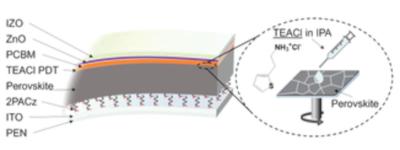Perovskite-Info weekly newsletter
Published: Tue, 10/25/22
The Perovskite-Info newsletter (October 25, 2022)
Cannot read this? View it online here
Researchers design unique bifacial monolithic all-perovskite tandem solar cells
A team of scientists, led by Professor Hairen Tan of Nanjing University, has demonstrated (for was the team states is the first time) bifacial all-perovskite monolithic tandem solar cells and examined their output power potential.
The research team demonstrated the design and fabrication of bifacial all-perovskite tandem solar cells using transparent conductive oxide (TCO) as the back electrode. The bandgap technique of the top subcell was used to obtain current matching under different backlights. The influence of the albedo on the photovoltaic parameters and the spectral sensitivity was systematically investigated. The bifacial tandems reportedly showed a high output power density of 28.51 mW cm−2 under a realistic rear illumination (30 mW cm− 2). Further energy yield calculation showed substantial energy yield gain for bifacial tandems compared with the monofacial tandems under various ground albedo for different climatic conditions. This work provides a new device architecture for higher output power for all-perovskite tandem solar cells under real-world conditions.
Researchers design spray-coated perovskite hemispherical photodetector
Researchers from China's Jilin University have designed a spray coated spherical perovskite photonic sensor made of phenyl ethyl ammonium/formamidinium lead halide (PEA2FAn-1PbnX3n+1). The researchers utilized the perovskite formulations to regulate the crystallization rate. Cyclic spray-coating and the solution concentration were used to control the coating thickness from a few nanometers to hundreds of micrometers.
Sphere imagers featuring specific wavelength recognition and wide-angle imaging are required in order to meet the fast development pace of modern technology. However, it remains challenging to deposit high-quality photosensitive layers on sphere substrates from low-cost solution processes. In this recent study, the team demonstrated the feasibility of using a rapid spray-coating procedure to fabricate perovskite hemispherical photodetectors that can execute lens-free scanning at nearly 180°, considerably decreasing the reliance on complex optical components.
Researchers create efficient and stable inverted perovskite solar cells via vacuum deposition
Researchers from Ulsan National Institute of Science and Technology (UNIST), Wuhan University of Technology and Foshan Xianhu Laboratory of the Advanced Energy Science and Technology Guangdong Laboratory have manufactured high efficiency, stable, and scalable perovskite solar cells (PSCs) via vacuum deposition, a method of fabricating organic light-emitting display devices (OLEDs).
In their study, the research team demonstrated efficient and stable PSCs with a vacuum-processed Ruddlesden-Popper (RP) phase perovskite passivation layer. By controlling the deposition rate of the RP phase perovskite, which directly influenced its crystallographic orientation, the research team successfully obtained a highly ordered 2D perovskite passivation layer.
Researchers achieve high-performance flexible all-perovskite tandem solar cell
Researchers from Empa, EPFL, Sichuan University, Jiaxing University, Soochow University, University of Cologne, University of Potsdam, HZB and the University of Oxford have developed a flexible all-perovskite tandem solar cell with a mitigated open-circuit voltage deficit and reduced voltage loss. The team reported flexible tandem efficiency of almost 24% on small area cells using the spin coating method.
Flexible all-perovskite tandem cells are currently less developed than rigid cells, due to a difficult deposition process for the cell's functional layers and a lower open-circuit voltage. This is due to high defect densities within the perovskite absorber layer and at the perovskite/charge selective layer interface.
Researchers utilize nano-optical designs for high-efficiency perovskite–silicon tandem solar cells
Researchers from Helmholtz-Zentrum Berlin (HZB) and Potsdam University have reported perovskite–silicon tandem solar cells with periodic nanotextures that offer various advantages without compromising the material quality of solution-processed perovskite layers. Textured tandem devices have been presented before, aiming at improved optical performance, but optimizing film growth on surface-textured wafers has thus far remained challenging.
The research team showed a reduction in reflection losses in comparison to planar tandems, with the new devices being less sensitive to deviations from optimum layer thicknesses. The nanotextures also enabled a greatly increased fabrication yield from 50% to 95%. Moreover, the open-circuit voltage was improved by 15 mV due to the enhanced optoelectronic properties of the perovskite top cell. The optically advanced rear reflector with a dielectric buffer layer resulted in reduced parasitic absorption at near-infrared wavelengths. As a result, the team achieved a certified power conversion efficiency of 29.80%.
Metalgrass LTD
9 Har Tsin St.
Kfar Sava Hasharon 4430809
ISRAEL
Unsubscribe | Change Subscriber Options







